The items listed below are a representative sample of the Holsters, Carriers, Pouches, and other pieces of miscellaneous webbing that were designed to be attached to and carried by W.E., Patt. '37, but were not actually listed as part of this Pattern. There were many others, and as previously mentioned Karkee Web will be very pleased to list any and all other examples that may be supplied by our readers.
A1/AA 0657 Case, pistol, web, R.T.C., with suspension strap and leg strap
A1/AA 0657 Case, pistol, web, R.A.C., with suspension strap and leg strap
A1/AA 0657 Case, pistol, web, R.A.C. (modified)
A1/AA 0657 Case, pistol, web, R.A.C., Mk. I
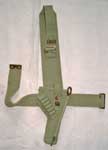
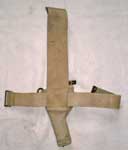 The early history of this Pistol case is covered under Patt. ’08 W.E. The earliest documentation of Patt. ’37 components did not list this Case. Some months passed before it was included as Case, pistol, web, R.T.C., the Royal Tank Corps, though armoured car units were to be issued with it as well as Royal Corps of Signals personnel, seconded to armoured units. A cryptic note was added, to the effect that the the new issue was to be “….of the 1937 pattern…”, which differed “…only slightly from the original type…”. This is somewhat of an under-statement, as the new issues had now acquired six cartridge loops, the cleaning rod sleeve moving to the front face! The pamphlet issued in 1939, illustrated the revised design, but still did not accord a “Patt. ’37 W.E.” nomenclature. In 1941, L. of C. §B4510 (approval date unknown) revised “R.T.C.” to “R.A.C.”, the Royal Armoured Corps having subsumed all armoured regiments.
The early history of this Pistol case is covered under Patt. ’08 W.E. The earliest documentation of Patt. ’37 components did not list this Case. Some months passed before it was included as Case, pistol, web, R.T.C., the Royal Tank Corps, though armoured car units were to be issued with it as well as Royal Corps of Signals personnel, seconded to armoured units. A cryptic note was added, to the effect that the the new issue was to be “….of the 1937 pattern…”, which differed “…only slightly from the original type…”. This is somewhat of an under-statement, as the new issues had now acquired six cartridge loops, the cleaning rod sleeve moving to the front face! The pamphlet issued in 1939, illustrated the revised design, but still did not accord a “Patt. ’37 W.E.” nomenclature. In 1941, L. of C. §B4510 (approval date unknown) revised “R.T.C.” to “R.A.C.”, the Royal Armoured Corps having subsumed all armoured regiments.
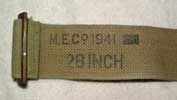 The example shown here is maker marked "M.E.Co." and dated 1940 on both the Case and Strap. The shape of the .38-inch web Case above was pared down into an open-topped format, the revolver now secured by a strap and press stud. On the back of the body, a long strap, 3-inches wide, was stitched to form a fairlead and extended some 20-inches above the Case mouth. The end 7-inches was reduction-woven to 1.5-inches, which mated with a buckle and chape stitched above the mouth of the holster, thus forming an adjustable belt loop. A two inch wide Strap, leg was provided, fitted with a 2-inch three-bar open buckle. The original Leg strap was 28-inches long, but L. of C. §B3113, approved on the 5th December, 1939, later notified an extra size of 32-inches. The picture at right shows a detail of stampings on an example of the shorter version of the Strap shown left. From the Allen Prior Collection. Photographs © 2009 Allen Prior.
The example shown here is maker marked "M.E.Co." and dated 1940 on both the Case and Strap. The shape of the .38-inch web Case above was pared down into an open-topped format, the revolver now secured by a strap and press stud. On the back of the body, a long strap, 3-inches wide, was stitched to form a fairlead and extended some 20-inches above the Case mouth. The end 7-inches was reduction-woven to 1.5-inches, which mated with a buckle and chape stitched above the mouth of the holster, thus forming an adjustable belt loop. A two inch wide Strap, leg was provided, fitted with a 2-inch three-bar open buckle. The original Leg strap was 28-inches long, but L. of C. §B3113, approved on the 5th December, 1939, later notified an extra size of 32-inches. The picture at right shows a detail of stampings on an example of the shorter version of the Strap shown left. From the Allen Prior Collection. Photographs © 2009 Allen Prior.

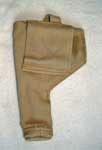 As might be expected, in the close confines of an armoured vehicle, the vertical strap was found to catch on internal protrusions. The broad strap was sometimes “shortened” by being wound around the Waist belt. The problem was then addressed in A.C.I. 2662/1942. The lines of stitching, forming the top of the fairlead for the leg strap, were to be cut. The 3-inch vertical strap was to be cut off ½-inch above the top of the Holster. This overlap was to be folded under and secured with only one line of stitches, forming a new fairway, but now for the Waist belt to pass through. L. of C. §B7399, approved 18th January, 1943, made it obsolescent. L. of C. §B8686, approved 27 October, 1943, introduced the Mark II Case and revised the nomenclature of the earlier variant to Case, pistol, web, R.A.C., Mk. I. It then remained for L. of C. §C2836, approved 9 January, 1947, to finally make the Mark I obsolete, still without any “Patt. ’37 W.E.” nomenclature. The example shown here is from the Allen Prior Collection. Photographs © 2009 Allen Prior.
As might be expected, in the close confines of an armoured vehicle, the vertical strap was found to catch on internal protrusions. The broad strap was sometimes “shortened” by being wound around the Waist belt. The problem was then addressed in A.C.I. 2662/1942. The lines of stitching, forming the top of the fairlead for the leg strap, were to be cut. The 3-inch vertical strap was to be cut off ½-inch above the top of the Holster. This overlap was to be folded under and secured with only one line of stitches, forming a new fairway, but now for the Waist belt to pass through. L. of C. §B7399, approved 18th January, 1943, made it obsolescent. L. of C. §B8686, approved 27 October, 1943, introduced the Mark II Case and revised the nomenclature of the earlier variant to Case, pistol, web, R.A.C., Mk. I. It then remained for L. of C. §C2836, approved 9 January, 1947, to finally make the Mark I obsolete, still without any “Patt. ’37 W.E.” nomenclature. The example shown here is from the Allen Prior Collection. Photographs © 2009 Allen Prior.
Case, pistol, web, R.A.C. Mk. I converted
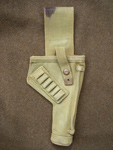
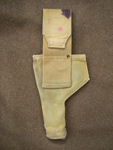
 This is a 1942 example of a Mark I, presumably modified by A.C.I. 2662/1942. However, it does not follow the instructions and could just be a user mod. Only the narrow strap has been cut off, together with the buckle, leaving it still as a “dropped” Holster, but not so inconveniently long as the issue Mark I. In this, it foreshadows the later Mark II in having high / low belt loops. From the Nick Wall Collection. Photographs © Nick Wall, 2013.
This is a 1942 example of a Mark I, presumably modified by A.C.I. 2662/1942. However, it does not follow the instructions and could just be a user mod. Only the narrow strap has been cut off, together with the buckle, leaving it still as a “dropped” Holster, but not so inconveniently long as the issue Mark I. In this, it foreshadows the later Mark II in having high / low belt loops. From the Nick Wall Collection. Photographs © Nick Wall, 2013.
The Case, pistol, web, R.A.C. Mk. I as a shoulder holster
Intended for use at the right thigh, modifications centred on shortening the broad support strap, either by rolling, or cutting (described above). At least one instance some lateral thinking – literally - has now been noted on a Commando who, in the normal course of things, did not have the R.A.C. holster in their particular Equipment Scales.
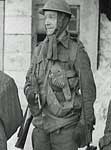
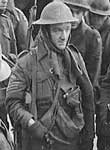 The Commandos were formed from volunteers from all branches of the British Army. Their raid on the Lofoten Islands, in 1941, was filmed for Pathe News and can be viewed at http://www.britishpathe.com/record.php?id=12534 , from which the two clips at left have been taken.
The Commandos were formed from volunteers from all branches of the British Army. Their raid on the Lofoten Islands, in 1941, was filmed for Pathe News and can be viewed at http://www.britishpathe.com/record.php?id=12534 , from which the two clips at left have been taken.
On the raid, the personnel included at least three volunteers, who were still wearing their distinctive white arm badge, on the right upper arm, showing that they had been recruited from the Royal Tank Regiment. The badge is a Great War “rhomboidal” tank and is still worn today. The particular clip showed two R.T.R. Troopers guarding two prisoners, one armed with a .45 Colt Automatic. On the opposite side is a Sergeant, with his R.A.C. Pistol case on his left upper chest, next to a Basic pouch. A later clip shows his right side, revealing his tank arm badge. The broad strap has been passed over his right shoulder. Under his left arm, the 2-inch Leg strap is visible, but only under the left arm – nothing appears passing round his waist to his right side. This would, in effect, be called en banderole.
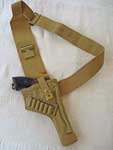
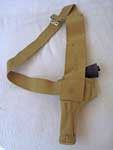

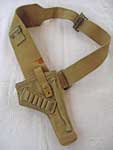 KWRT member, Terry Hawker has performed some experimental accoutrementology - of a non-permanent nature -in order to work out how this was achieved.
KWRT member, Terry Hawker has performed some experimental accoutrementology - of a non-permanent nature -in order to work out how this was achieved.
The Leg strap has to be secured near the holster belt loop, possibly being stitched, to give the maximum length. Alternatively, if the modification was not to be permanent, it could be doubled through the belt loop and be secured back to itself with a spare Buckle, brass, 2-in.. This would shorten the strap considerably, but it would depend on the Sergeant’s physique. Though stitching is the more likely, a pair of rivets through the Shell Rivets on the Tip, brass, 1 ½-in. and the edge of the Leg strap loop would also achieve the same end. The tapered end of the broad strap is then secured to the 2-inch buckle on the Leg strap. The mating of a 1.5-inch strap to a 2-inch buckle could be made more secure by doubling the 1.5-inch running end back over the open-bar and under the closed bar of the buckle. The photos on left show the first suggested method, with the Leg strap secured near the Holster belt loop. The photos on the right show the same Holster and Strap, but this time with the Leg strap doubled through the Belt loop.
This is a unique use – unless KW readers can find another example…?!
Stores Ref. B3 / BL / C / 0122 Holster, pistol, auto, 9mm. wooden
Stores Ref. B3 / CGB 414 A Holster, 9-mm. Browning pistol, “C”, No. 1, Mk. 1.
Stores Ref. (unknown) Belt runner with snap hook (nomenclature unknown)
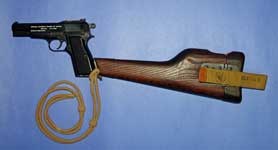 This wooden item would seem a very odd thing to include in an account of a web equipment. However, it was connected to the Patt. ’37 Waist belt and it is listed in V.A.O.S. Section B3. The concept was not new, the “Broomhandle” Mauser pistol employing a near identical form. However, the Mauser was always an officer’s private purchase, carried by such as Winston Churchill, both in the Sudan and South Africa. Within the British Army, four decades on, it is rather less clear quite who actually needed a Holster cum shoulder stock.
This wooden item would seem a very odd thing to include in an account of a web equipment. However, it was connected to the Patt. ’37 Waist belt and it is listed in V.A.O.S. Section B3. The concept was not new, the “Broomhandle” Mauser pistol employing a near identical form. However, the Mauser was always an officer’s private purchase, carried by such as Winston Churchill, both in the Sudan and South Africa. Within the British Army, four decades on, it is rather less clear quite who actually needed a Holster cum shoulder stock.
During the War, the Browning Mk 1 was being made in Canada, by Inglis, for contracts let by the Chinese Nationalists. The carbine concept, afforded by such as the Luger and particularly the Mauser, suited their purposes and they therefore specified the same for the Browning, together with a compact webbing Holster, the No. 1, Mk. II (if in Canada), or No. 2 Mk. 1 (if in the U.K.). These are covered elsewhere in the Patt. ’37 W.E. account. Where the Mauser had a long barrel, with attendant accuracy over distance, there would have been some merit. However, the far shorter Browning barrel calls into question the value of adding a Stock.
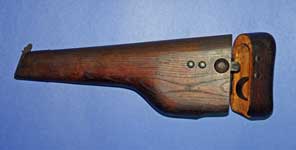
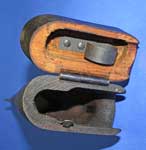 For this Holster / stock to have found its way into the U.K. inventory, may simply been that the Mark 1 pistol was supplied, as a standard “package”, with a Holster / stock, so it had to be entered up in Section B3! It remains for readers to un-earth photographic evidence of the stock in use with British troops – in any year! Ed Storey has commented that the tangent sights on the Chinese contract Mk. 1 and 1* were only removed from Canadian stores in the 1990s.
For this Holster / stock to have found its way into the U.K. inventory, may simply been that the Mark 1 pistol was supplied, as a standard “package”, with a Holster / stock, so it had to be entered up in Section B3! It remains for readers to un-earth photographic evidence of the stock in use with British troops – in any year! Ed Storey has commented that the tangent sights on the Chinese contract Mk. 1 and 1* were only removed from Canadian stores in the 1990s.
The Holster body was a hollowed-out block of hardwood, closed with a hinged lid, which was secured with a spring-button catch. Both the lid and body were relieved, to accommodate the butt. The lid hinge had a heavy wire staple, mounted to the hinge half on the body. At the muzzle end of the Holster, a tee-section metal piece was attached, fitted with a spring-loaded, hinged catch. This fitted into a corresponding tee slot in the rear edge of the pistol butt. Only the Browning No. 1 Mk. 1 and 1* had tangent sights and were therefore fitted up for a shoulder stock. The No. 1 Mk. 2 and 2* had plain rear sight and a plain butt.
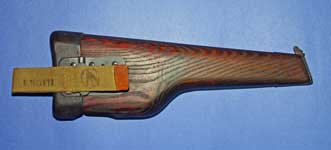
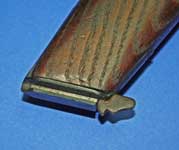 There does not appear to be any item listed that equates to the Belt runner, whatever permutations of synonyms are tried. It comprised a length of 1.25-inch webbing folded over to form a Belt loop and with the end turned under to secure a broad snap hook. The other end of the webbing extended beyond the hook and was finished – Canadian style – by being dipped in phenolic resin. The staple on the body hinge plate was attached to the runner hook. No photograph has yet been noted, where this Holster is being worn. The picture near left shows the attachment details where the stock fits to the butt of the pistol.
There does not appear to be any item listed that equates to the Belt runner, whatever permutations of synonyms are tried. It comprised a length of 1.25-inch webbing folded over to form a Belt loop and with the end turned under to secure a broad snap hook. The other end of the webbing extended beyond the hook and was finished – Canadian style – by being dipped in phenolic resin. The staple on the body hinge plate was attached to the runner hook. No photograph has yet been noted, where this Holster is being worn. The picture near left shows the attachment details where the stock fits to the butt of the pistol.
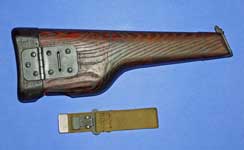
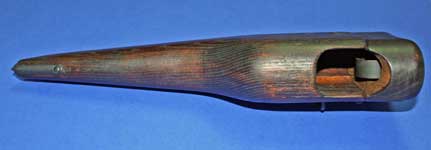 The pistol and Stock assembly shown in this section are from the Ed Storey Collection. Photographs © Ed Storey 2009.
The pistol and Stock assembly shown in this section are from the Ed Storey Collection. Photographs © Ed Storey 2009.
(a) Stores Ref. B3 / BL / C / 0120 Case, Magazine, Pistol, Automatic, 9mm.
(b) Stores Ref. B3 / BL / C / 0121 Case, Magazine, Pistol, Automatic, 9mm.
(c) Stores Ref. B3 / BL / C / 10102 Pouch, magazine, 9-mm. Browning Pistol, “C” Mk. 1.
(d) Stores Ref. B3 / CGB 7186 Pouch, magazine, 9-mm. Browning Pistol, “C” Mk. 1.
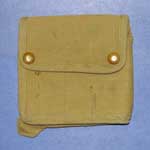
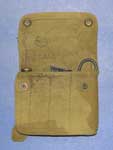 This Pouch epitomises the difficulty facing the researcher, even when he has Prime Sources. The above nomenclatures come from two editions of a V.A.O.S. Section B3. By their rough-and-ready formats, these were both provisional forms, which may have some bearing. In the 1944 edition, there is no “Pouch” and conversely, that of 1946 has no “Case”! The choice of “Case” also seems curious, but is not thought to indicate that it was a wooden transit package. From other conventional uses, being a divided receptacle, an argument could be advanced for this to be a Carrier! Whilst the purpose is obvious, precisely which Case, or Pouch is depicted?! The example shown here is maker marked "Z.L. & T.", for Zephyr Loom & Textile Ltd. and is dated 1944. From the Ed Storey Collection. Photographs © Ed Storey 2009.
This Pouch epitomises the difficulty facing the researcher, even when he has Prime Sources. The above nomenclatures come from two editions of a V.A.O.S. Section B3. By their rough-and-ready formats, these were both provisional forms, which may have some bearing. In the 1944 edition, there is no “Pouch” and conversely, that of 1946 has no “Case”! The choice of “Case” also seems curious, but is not thought to indicate that it was a wooden transit package. From other conventional uses, being a divided receptacle, an argument could be advanced for this to be a Carrier! Whilst the purpose is obvious, precisely which Case, or Pouch is depicted?! The example shown here is maker marked "Z.L. & T.", for Zephyr Loom & Textile Ltd. and is dated 1944. From the Ed Storey Collection. Photographs © Ed Storey 2009.
The absence of Belt hooks suggests this was a companion to the “Chinese” Holster, No. 2, Mk. 1, which also had only a Belt loop, i.e. (b) above, which was detailed in the Remarks column as being “…For Webbing Holster… “. That being the case, why should there be another Case (a) which was similarly defined as “…For Wooden Holster…”. In what way could the latter be different?
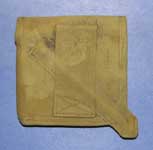
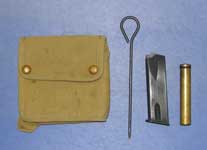 At this stage, it can only be speculated, but the wooden Holster, No. 1, Mk. 1 had no provision for a cleaning rod, which would make this pouch the ideal companion. The Holster, No. 2, Mk. 1 had an internal leather cleaning rod sleeve, so perhaps (a) above was the same Pouch, but without the cleaning rod sleeve? It might also be a Pouch for two magazines and the oil bottle, as Holster No. 2, Mk. 1 would carry the third magazine. It is at least a plausible argument. Unfortunately, the date of 1944 means that no stores code was stencilled on. In addition to provision for three magazines, there is a narrower fourth cell for an oil bottle, with a diagonally placed cleaning rod sleeve stitched to the back of the Pouch.
At this stage, it can only be speculated, but the wooden Holster, No. 1, Mk. 1 had no provision for a cleaning rod, which would make this pouch the ideal companion. The Holster, No. 2, Mk. 1 had an internal leather cleaning rod sleeve, so perhaps (a) above was the same Pouch, but without the cleaning rod sleeve? It might also be a Pouch for two magazines and the oil bottle, as Holster No. 2, Mk. 1 would carry the third magazine. It is at least a plausible argument. Unfortunately, the date of 1944 means that no stores code was stencilled on. In addition to provision for three magazines, there is a narrower fourth cell for an oil bottle, with a diagonally placed cleaning rod sleeve stitched to the back of the Pouch.
The nomenclature at (c) is from the Remarks column against (d), which states “…Formerly BL / C / 10102 CSAID3-2018…”, which latter reference is a Drawing Number. Once again, a coded example would be rather useful, if not the drawing itself! The final nomenclature at (d) is from the 1946 listing of B3, again with a “provisional” look to it. It is not known if this is (b), with a new nomenclature, or yet another design. The balance of probability is that it was (b).
It is not thought that (d) is similar to the two-cell A1/AA 5199 Pouch, magazine, Colt, shown elsewhere in this section. Though this will accept HP magazines and would constitute a sensible “pair”, with either the Holster No. 2, Mk. 1, or the Mk. 2, as both Holsters have internal cleaning rod sleeves. It would leave no provision for an oil bottle, which seems to have been considered an important accessory.
Resolution can only come from coded examples, from 1945 onwards, when codes started to be marked-on. If any reader has coded examples…?
Stores Ref. B3 / BL / C / 0127 Holster, pistol, auto. 9mm., webbing
Stores Ref. B3 / CGB 7190 Holster, 9-mm. Browning Pistol, “C” No. 2. Mk. 1
Stores Ref. CN / CGB / 7190 Holster, webbing, No. 2, Mk. 1
Stores Ref. CN 7190 Holster, web, No. 2, Mk. 1
Stores Ref. 8440-99-973-6257 Holster, pistol, web, No. 2, Mk. 1

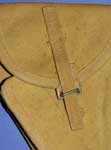
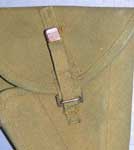 The presence of this Holster - not Case - in V.A.O.S. Section B3 (Composite List), 1944, allows its inclusion here, rather than in future coverage of Patt. ’37 Empire Variants. The Browning Hi-Power was a large and impressive weapon, but the Holster No. 2 Mk. 1 was an un-impressive and little design. It was originally intended to carry the Inglis Brownings made for the Chinese Nationalists and was of triangular front elevation, closed by a “long-strap” Q.R. buckle, but later the more standard “short-strap” type. Adjacent to the underside of the pistol, a metal liner was inserted, riveted through the webbing Holster body. This contained one 13-round magazine, the pocket closed by a small, side-hinged flap. A broad, half-standing belt loop was stitched to the back, and sewn to the inside rear face was a leather sleeve for the cleaning rod. The picture far left shows the first ("long-strap") issue left, and the second ("short-strap") issue on the right. The detail photos centre left and near left show the first and second issues respectively. Both of these Holsters are from the Ed Storey Collection. Photographs © Ed Storey 2009.
The presence of this Holster - not Case - in V.A.O.S. Section B3 (Composite List), 1944, allows its inclusion here, rather than in future coverage of Patt. ’37 Empire Variants. The Browning Hi-Power was a large and impressive weapon, but the Holster No. 2 Mk. 1 was an un-impressive and little design. It was originally intended to carry the Inglis Brownings made for the Chinese Nationalists and was of triangular front elevation, closed by a “long-strap” Q.R. buckle, but later the more standard “short-strap” type. Adjacent to the underside of the pistol, a metal liner was inserted, riveted through the webbing Holster body. This contained one 13-round magazine, the pocket closed by a small, side-hinged flap. A broad, half-standing belt loop was stitched to the back, and sewn to the inside rear face was a leather sleeve for the cleaning rod. The picture far left shows the first ("long-strap") issue left, and the second ("short-strap") issue on the right. The detail photos centre left and near left show the first and second issues respectively. Both of these Holsters are from the Ed Storey Collection. Photographs © Ed Storey 2009.
No introductory L. of C. has been found, so the earliest reference is in the December 1944 Composite List of Section B3. The format of the nomenclature is more simplified than that in L. of C. §C1918 for the No.2, Mk. 2. The disparity between the stores codes, 7190 and 10004 is not understood. At this stage, it was still “N.I.V.”, which was rectified by L. of C. §C6789, approved on 14 Jul, 1955, confirming the shorter CN / CGB / 7190 code and nomenclature and transferring it and the Mark 2 from Section B3 to C.C.N. Section CN, which was the old V.A.O.S. Section A1, re-vamped by §C4686 in 1951. The higher code, for a lower Mark, is noteworthy and is thought to result from the Mark 1 being taken into service later than the Mark 2, as an expedient.
L. of C. §C4686 divided up Section CN under sub-headings for W.E. Patts. ’37, ’40 and ’44. In the 1960 edition of C.C.N. Section CN, but both Marks of the HP holster had appeared under Miscellaneous. Now in the 1965 edition, only the No. 2, Mk. 1 Holster remained in Miscellaneous. No Detail was appended concerning the weapon, though this was the Browning. It therefore never achieved “Patt. ’37 W.E.” status but, lacking belt hooks, it would have been stretching a point to have given it that nomenclature.
Holster, pistol, web, No. 2, Mk. 1 was still present in the 1976 edition of C.O.S.A., now as NSN 8440-99-973-6257. This is remarkable on two counts, the more obvious of which is the Nation Code of “99” – the U.K. - who had not designed this item, let alone ever manufactured it. Other holsters being Group / Class 1095, Miscellaneous Weapons, the clerk’s choice of 8440 signifies Hoisery (sic!), handwear, and clothing accessories, men’s. Includes handkerchiefs; suspenders; garters; belts; dress handwear; leggings, nonsafety (sic!) type. Lest suspenders raise a flutter in the male reader’s hearts, it should be pointed out that these are trouser suspenders – braces in U.K. terms! Rather wide of the mark as a Holster classification.
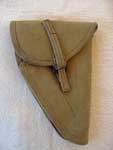
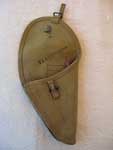
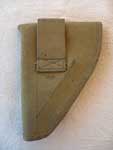 Another example of the "long-strap" version of this Holster, this time showing the interior and rear. The cleaning rod sleeve is just visible in the center photo. This Holster is maker marked "Z.L. & T." and dated 1944. From the Terry Hawker Collection, photographs © Terry Hawker 2009.
Another example of the "long-strap" version of this Holster, this time showing the interior and rear. The cleaning rod sleeve is just visible in the center photo. This Holster is maker marked "Z.L. & T." and dated 1944. From the Terry Hawker Collection, photographs © Terry Hawker 2009.
Stores Ref. A1/AA unknown Pouch, filler, magazine
Stores Ref. A1/AA unknown Pocket, Sten loading tool

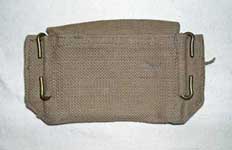 Nomenclature for this item is not known. Pouch, filler, magazine is abstracted from R.A.F. A.P. 1086 listings for Patt. ’25 items, where it was appended to 23/101 Pouch, ammunition, pistol, Patt. ’25 W.E. Pocket, Sten loading tool is derived from the R.A.F. sub-detail - “…With tool pocket…”) for 23/190 Pouch, magazine, machine carbine, which held 50-round magazines for the Lanchester M.C.. The assumption is that the Mark III Basic Pouch could have been augmented by this Pouch, in order to carry the Sten Magazine Loading Tool, Marks 1, 2 or 3 (Mark 4 was small by comparison, i.e. trouser pocket size). Evidence for its use is slender, to say the least, resting solely on two wartime photographs (not to hand). The first was published in “Soldier” magazine, August 1977, P.11 and shows a pistol armed dispatch rider (D.R.) in Europe in 1944. The second (below right, from They Also Served, by George Forty) is one “soldier” queuing for char & a wad, at a mobile N.A.A.F.I. van. Unfortunately, this is a R.A.F. soldier, namely a member of the R.A.F. Regiment. However, his webbing is drab, not blue-grey and the pouch is being worn just behind his right Basic pouch. He would have had no use for this as a Pistol ammunition pouch…?
Nomenclature for this item is not known. Pouch, filler, magazine is abstracted from R.A.F. A.P. 1086 listings for Patt. ’25 items, where it was appended to 23/101 Pouch, ammunition, pistol, Patt. ’25 W.E. Pocket, Sten loading tool is derived from the R.A.F. sub-detail - “…With tool pocket…”) for 23/190 Pouch, magazine, machine carbine, which held 50-round magazines for the Lanchester M.C.. The assumption is that the Mark III Basic Pouch could have been augmented by this Pouch, in order to carry the Sten Magazine Loading Tool, Marks 1, 2 or 3 (Mark 4 was small by comparison, i.e. trouser pocket size). Evidence for its use is slender, to say the least, resting solely on two wartime photographs (not to hand). The first was published in “Soldier” magazine, August 1977, P.11 and shows a pistol armed dispatch rider (D.R.) in Europe in 1944. The second (below right, from They Also Served, by George Forty) is one “soldier” queuing for char & a wad, at a mobile N.A.A.F.I. van. Unfortunately, this is a R.A.F. soldier, namely a member of the R.A.F. Regiment. However, his webbing is drab, not blue-grey and the pouch is being worn just behind his right Basic pouch. He would have had no use for this as a Pistol ammunition pouch…?
And yet another possibility: KWRT Member Allen Prior reports "seeing one man's kit from Malaya including a set of 1944 patt webbing with one of these pouches blancoed green - it contained a field dressing. I have tried for myself and the FFD fits perfectly."
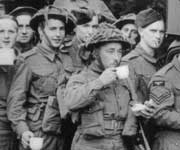 The D.R. appears to have no Sten Gun, so may have been using it as a large capacity Pistol ammunition pouch (no pistol is visible either), which was its original use. It may even have been appropriated from Naval sources, as the pouch was in reality a Pattern 1919 design. If the D.R. photograph is an indication of wider Army use - with the pistol and not the Sten, the nomenclature would need to be different. “Pouch, ammunition, pistol, W.E. Patt. ‘37” was obviously already in use, reference to “Patt. ‘19” is unlikely, leaving “Pouch, ammunition, pistol, large” as a possibility, though not confirmed by any known Section A1 document. If for a magazine filler, it may of course have been coded in Section B3. Does any reader have confirmation - either way?
The D.R. appears to have no Sten Gun, so may have been using it as a large capacity Pistol ammunition pouch (no pistol is visible either), which was its original use. It may even have been appropriated from Naval sources, as the pouch was in reality a Pattern 1919 design. If the D.R. photograph is an indication of wider Army use - with the pistol and not the Sten, the nomenclature would need to be different. “Pouch, ammunition, pistol, W.E. Patt. ‘37” was obviously already in use, reference to “Patt. ‘19” is unlikely, leaving “Pouch, ammunition, pistol, large” as a possibility, though not confirmed by any known Section A1 document. If for a magazine filler, it may of course have been coded in Section B3. Does any reader have confirmation - either way?
The example illustrated is "M.E. Co." marked and dated 1942, which is felt to be late for a Navy contract, most Patt. ’19 manufacture being 1940, with some in 1941. It does not have the “Arrow over N” Naval ownership mark. This may confirm it as an Army example. From the Karkee Web Collection.
Stores Ref. Naval code unknown Pouch, Magazine, Carbine, Machine, Lanchester, Left, Converted REVISED!
Stores Ref. Naval code unknown Pouch, Magazine, Carbine, Machine, Lanchester, Right, Converted With tool pocket
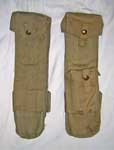
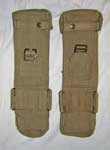 The above nomenclatures are abstracted from Admiralty Fleet Order 4187 / 1943, as no naval Stores Vocabularies have been seen. The A.F.O. does not give an explicit new nomenclature, so KW has added “Converted”. The Lanchester Machine Carbine was the weapon of choice for the Royal Air Force and the Royal Navy, originally on a 50:50 split. The Magazine pouches had therefore to be designed for different compatibility, in addition to their colour. For the R.A.F. they had to fit onto the Pieces, side of the Waist belt of Patt. ’25 W.E., but for the R.N. Patt. ’08, W.E. they had additional to provide support for the Patt. ’08 Pack.
The above nomenclatures are abstracted from Admiralty Fleet Order 4187 / 1943, as no naval Stores Vocabularies have been seen. The A.F.O. does not give an explicit new nomenclature, so KW has added “Converted”. The Lanchester Machine Carbine was the weapon of choice for the Royal Air Force and the Royal Navy, originally on a 50:50 split. The Magazine pouches had therefore to be designed for different compatibility, in addition to their colour. For the R.A.F. they had to fit onto the Pieces, side of the Waist belt of Patt. ’25 W.E., but for the R.N. Patt. ’08, W.E. they had additional to provide support for the Patt. ’08 Pack.
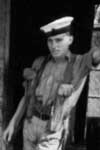 Probably around 1941, if they followed the R.A.F. decision, the R.N. adopted Patt. ’37 and made Patt. ’08 obsolete. This was a logical move, with manufacturers now able to concentrate on a webbing Pattern common to all three Services. Thus their ‘08 Lanchester pouches required modification, which was detailed in Admiralty Fleet Order 4187, approved on 9 September 1943, though the promulgation date is not known. The word used was “obsolete”, not “obsolescent”, yet the 1945 photograph of H.M.S. Cumberland sailors at right shows many of them still in Patt. ’08, although the two carrying Lanchesters are in either Patt. '37 or '19, and are carrying Pouches either made or converted for Patt. '37. It was the Far East, so perhaps they had yet to catch up! A fuller description will be found below, under the section for newly manufactured Patt. ’37 Lanchester pouches. All the fittings on the rear of the Pouches were stripped off and new ones added, which replicated the form of the R.A.F. Pouches. The patches carrying the “C” hooks now extended slightly beyond the vertical edges and the closed Brace loop, at the top of the Pouches, was changed to a new loop in two sections, which fastened with a press stud. The Pouches were still “handed”, though now only by virtue of the tool pocket on the right-hand Pouch, otherwise they were interchangeable and the Cumberland sailors were wearing pairs of left-hand Pouches.
Probably around 1941, if they followed the R.A.F. decision, the R.N. adopted Patt. ’37 and made Patt. ’08 obsolete. This was a logical move, with manufacturers now able to concentrate on a webbing Pattern common to all three Services. Thus their ‘08 Lanchester pouches required modification, which was detailed in Admiralty Fleet Order 4187, approved on 9 September 1943, though the promulgation date is not known. The word used was “obsolete”, not “obsolescent”, yet the 1945 photograph of H.M.S. Cumberland sailors at right shows many of them still in Patt. ’08, although the two carrying Lanchesters are in either Patt. '37 or '19, and are carrying Pouches either made or converted for Patt. '37. It was the Far East, so perhaps they had yet to catch up! A fuller description will be found below, under the section for newly manufactured Patt. ’37 Lanchester pouches. All the fittings on the rear of the Pouches were stripped off and new ones added, which replicated the form of the R.A.F. Pouches. The patches carrying the “C” hooks now extended slightly beyond the vertical edges and the closed Brace loop, at the top of the Pouches, was changed to a new loop in two sections, which fastened with a press stud. The Pouches were still “handed”, though now only by virtue of the tool pocket on the right-hand Pouch, otherwise they were interchangeable and the Cumberland sailors were wearing pairs of left-hand Pouches.


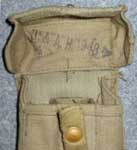 The original stitching guide lines were left more visible on the modified Pouches. It is of interest that new manufacture examples exist of both Patt. ’08 and ’37 in 1941. The stitching guides are therefore also a guide as to the origin of some Patt. ’37 Pouches.
The first pair of converted Pouches, shown at the beginning of this section, are maker marked "M" and dated 1943. From the Karkee Web Collection. Another converted right-hand Pouch is shown at left. Note the fabrication marks showing where the original '08 fittings were placed, as well as the scars on the webbing where the old bits were removed, which are particularly well shown on this example. This Pouch is maker marked "J. & A.H." (J. & A. Hillman) and dated 1943. From the Graham Tweeddale Collection. Photographs © Graham Tweeddale, 2012.
The original stitching guide lines were left more visible on the modified Pouches. It is of interest that new manufacture examples exist of both Patt. ’08 and ’37 in 1941. The stitching guides are therefore also a guide as to the origin of some Patt. ’37 Pouches.
The first pair of converted Pouches, shown at the beginning of this section, are maker marked "M" and dated 1943. From the Karkee Web Collection. Another converted right-hand Pouch is shown at left. Note the fabrication marks showing where the original '08 fittings were placed, as well as the scars on the webbing where the old bits were removed, which are particularly well shown on this example. This Pouch is maker marked "J. & A.H." (J. & A. Hillman) and dated 1943. From the Graham Tweeddale Collection. Photographs © Graham Tweeddale, 2012.
Stores Ref. Naval code unknown Pouch, Magazine, Carbine, Machine, Lanchester, Left, W.E., Patt. ‘37
Stores Ref. Naval code unknown Pouch, Magazine, Carbine, Machine, Lanchester, Right, With tool pocket, W.E., Patt. ‘37
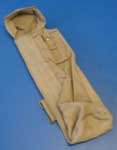
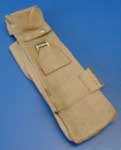
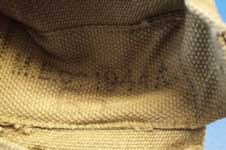 The above nomenclatures are abstracted from Admiralty Fleet Order 4187 / 1943. They ought to have been “Carriers, Magazine,etc”, as they had internal divisions.
The above nomenclatures are abstracted from Admiralty Fleet Order 4187 / 1943. They ought to have been “Carriers, Magazine,etc”, as they had internal divisions.
The 50-round box magazine, for the Lanchester, was the biggest ever to see service with a British weapon. It should be noted that the 32-round Sten magazine was compatible also. Reverse-engineered from the Bergmann M.P. 28, the weapon was also over-engineered, so perhaps the capacity of the magazine was overkill - no pun intended! It did present considerable problems in carriage and these were not comfortably solved by the chosen Pouch, which extended up the chest almost to the level of the chin - very uncomfortable.
The general principles of Basic pouch manufacture re-appear here, though the 4-bar buckle and chape are almost half way down the Pouch. The double hooks are carried on a 2-inch wide patch that is extended beyond the edges of the Pouch. At the very top of the Pouch, a two-part press studded loop is attached to fit around the Brace. When all that was done, it must have been like wearing a Victorian corset. The right Pouch has a small, box-lidded pocket low down on the front face. This was for the Mark 1, 2 or 3 Magazine Loading Tool, but was large enough to contain other items, e.g. a cleaning kit, though this is not documented. The contract for the Lanchester was jointly let by the Admiralty and Air Ministry, but in the event most went to the Royal Navy, where they formed part of shipboard personal arms into the late 1960s. The left hand Pouch shown here is maker marked "M.E. Co." and dated 1944. From the Brian Burns Collection, photos © Brian Burns 2012.
Stores Ref. unknown Pouch, Magazine, Carbine, Machine, Lanchester (Re-dyed)


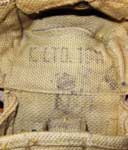 Once again, the nomenclature is from the A.F.O., but with “Re-dyed” added to make it discrete. This example appears to be a new manufacture Patt. ’37 Lanchester pouch, but carries the Crowned A.M. ownership stamp of the R.A.F.. Close examination of the seams reveal that it was actually blue-grey and it has been re-dyed to khaki.
Once again, the nomenclature is from the A.F.O., but with “Re-dyed” added to make it discrete. This example appears to be a new manufacture Patt. ’37 Lanchester pouch, but carries the Crowned A.M. ownership stamp of the R.A.F.. Close examination of the seams reveal that it was actually blue-grey and it has been re-dyed to khaki.
However, it begs a question: has a now surplus Pouch been officially transferred to the Royal Navy? The alternative is that the R.A.F. did have some Lanchesters, prior to the majority being taken by the Navy. The R.A.F. termed their khaki ’08 and ’37 as “drab” and the latter was intended for the R.A.F. “army” component - the R.A.F. Regiment - who were formed in 1942. Not one photograph has yet been seen of an airmen armed with a Lanchester, neither dressed in blue-grey Service Dress, nor Khaki Drill. Manufactured by K. LTD (either Kensum, or Knibbs) in 1941, this example is from the Graham Tweeddale Collection. Photographs © Graham Tweeddale, 2012.
Stores Ref. unknown Pouch, Magazine, Carbine, Machine, Lanchester (shortened)
 A few examples of khaki Pouches for Sten magazines have been encountered. In all cases they have proved to be Lanchester pouches, shortened at their lower ends, as the Sten used smaller, 32 round magazines. The khaki left Pouch illustrated is of particular interest, being made from a right-hand blue-grey Lanchester version. The stencilled stitch line area for the box lid gives the game away and retains the original colour, as it was dyed khaki prior to being cut down. It begs the question as to the existence of left and right versions, as here the removed pocket has not been re-attached. Perhaps, as it overcomplicated the conversion, it was dispensed with. They are a far from tidy conversion, which leads to an assumption that they were “locally modified”, i.e. not by a manufacturer. By the same token, if it was a manufacturer’s trial batch, they would have been better finished.
A few examples of khaki Pouches for Sten magazines have been encountered. In all cases they have proved to be Lanchester pouches, shortened at their lower ends, as the Sten used smaller, 32 round magazines. The khaki left Pouch illustrated is of particular interest, being made from a right-hand blue-grey Lanchester version. The stencilled stitch line area for the box lid gives the game away and retains the original colour, as it was dyed khaki prior to being cut down. It begs the question as to the existence of left and right versions, as here the removed pocket has not been re-attached. Perhaps, as it overcomplicated the conversion, it was dispensed with. They are a far from tidy conversion, which leads to an assumption that they were “locally modified”, i.e. not by a manufacturer. By the same token, if it was a manufacturer’s trial batch, they would have been better finished.
Obviously, it has been obtained from R.A.F. sources, either officially or “scrounged”, but by whom? Airman, soldier or even sailor and why? Military Illustrated magazine, issue No. 54, Page 21, illustrates and states that they were an Airborne stop-gap. Since the Sten Bandolier existed at least as early as 1942 (see below), there ought not to have been a need. An alternative theory suggests itself: the R.A.F had charge, then and still, of parachute training for the Army. The lack of a suitable Pouch would very probably have been identified during training. As most of the Lanchesters went to the Navy, it would make sense to use the R.A.F.’s largely redundant Pouches. Equally, the new R.A.F. Regiment may have needed an urgent stop-gap for the 60,000 Stens that were obtained after April 1941. Though these are plausible arguments, official documentation is essential, for example an A.M.O. authorising the conversion, at unit level, of R.A.F. property for issue to the Army, or for the R.A.F. Regiment. An additional view heard was that they were Naval conversions for Royal Marines. Avoiding the problems of transferring R.A.F. stores to the Navy, use by the R.A.F.Regiment is an attractive theory.
Unlike factory made blue-grey Sten magazine carriers / pouches, no factory made drab Sten pouch has been noted. All are conversions from Lanchester pouches. The writer was once told by an ex (post-war) Army officer that drab Sten pouches did exist. Can anyone confirm their existence…?
The example shown above is from the Roger Dennis Collection, photograph © 1990 by Martin Brayley.
Stores Ref. A1/AA 1501 Pouch, magazine, C.M.T.
Stores Ref. A1/AA 1502 Pouch, magazine, C.M.T., strap, web, 1-in. x 30-in.
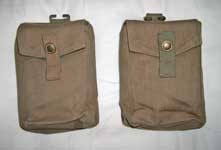
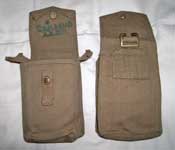
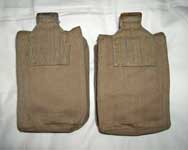 Of all the Pouches authorised this is the most puzzling. The nomenclature in L. of C. §B5789 is clear, “C.M.T.” being the Carbine, Machine, Thompson, but no method of wearing is given. In form, it is a mini Basic pouch, but with a flap lid in place of the more normal box lid. A 3-bar buckle, on a reduction weave chape, is fitted at the top, just like the Basic pouch. However, no belt hooks were provided, nor are there stitching guides to indicate an incompletely finished product. The only other information was the Strap, Web, 1-in. x 30-in. that was also notified in the L. of C.. It is too well-made to be a temporary, or supply Carrier, to be thrown away after it reaches its destination - unless it needed to be sturdily made for use as a throw-away by Airborne troops…?
Of all the Pouches authorised this is the most puzzling. The nomenclature in L. of C. §B5789 is clear, “C.M.T.” being the Carbine, Machine, Thompson, but no method of wearing is given. In form, it is a mini Basic pouch, but with a flap lid in place of the more normal box lid. A 3-bar buckle, on a reduction weave chape, is fitted at the top, just like the Basic pouch. However, no belt hooks were provided, nor are there stitching guides to indicate an incompletely finished product. The only other information was the Strap, Web, 1-in. x 30-in. that was also notified in the L. of C.. It is too well-made to be a temporary, or supply Carrier, to be thrown away after it reaches its destination - unless it needed to be sturdily made for use as a throw-away by Airborne troops…?
Correspondence with NAM has failed to give the method of wearing. It is tempting to assume the Strap is used to link two Pouches, in the manner of the Utility pouches, but those had a Waist strap. This has nothing. Perhaps they were worn around the parachutist’s neck, under the various smocks and overalls …?
There is a photo in Military Illustrated magazine, No. 13, where Page 20 shows some odd Pouches, of the right size, worn at the front and below the Belt of Polish paratroops. The flap is not box sided and the Pouches are supported by strapping wrapped around the Belt. The photo is not very clear, but there is an odd arrangement which just might be these Pouches. If true, it has to be the crudest method yet seen. The Strap is not long enough for wear around the neck and for the Strap to be held under the Waist belt. They would have flapped around there, even had it been longer. KW would particularly like to hear from anyone who can solve the methodology, or who has any brighter ideas. Both Pouch and Strap were made obsolete by L. of C. §C4686 (10th April, 1951). The example show above is maker marked "C & P" and dated 1945. From the Chris Pollendine Collection. Photographs © Chris Pollendine, 2009.
Stores Ref. A1/AA 5199 Pouch, magazine, Colt
 Photographs show the Army used this item, yet neither code, nor nomenclature appear in any V.A.O.S. entry so far seen. The above nomenclature was noted by Carl Woods from wartime contract records. In form, it is exactly like the version manufactured for R.A.F. Patt. ’25 W.E., though the R.A.F. termed it – correctly – a Carrier, it being a divided pocket! Of the Pouches so far noted, all are with either Commando, or Airborne personnel and, in the case of the latter, even one with a Royal Army Medical Corps officer. Medics with guns - anybody know how that works?! A Sealed Pattern, dated 1940 has been noted and the example illustrated (spot the deliberate error) was made by Associated Cutters in 1941. Photograph © Carl Woods, 2009.
Photographs show the Army used this item, yet neither code, nor nomenclature appear in any V.A.O.S. entry so far seen. The above nomenclature was noted by Carl Woods from wartime contract records. In form, it is exactly like the version manufactured for R.A.F. Patt. ’25 W.E., though the R.A.F. termed it – correctly – a Carrier, it being a divided pocket! Of the Pouches so far noted, all are with either Commando, or Airborne personnel and, in the case of the latter, even one with a Royal Army Medical Corps officer. Medics with guns - anybody know how that works?! A Sealed Pattern, dated 1940 has been noted and the example illustrated (spot the deliberate error) was made by Associated Cutters in 1941. Photograph © Carl Woods, 2009.
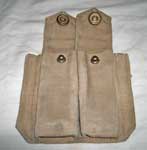
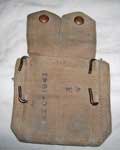 Another example. This one, made by the Mills Equipment Company, is integrally woven, except for the flaps, unlike the folded and stitched example shown above. Maker marked "M.E. Co." and dated 1943. From the Chris Pollendine Collection. Photograph © Chris Pollendine, 2009.
Another example. This one, made by the Mills Equipment Company, is integrally woven, except for the flaps, unlike the folded and stitched example shown above. Maker marked "M.E. Co." and dated 1943. From the Chris Pollendine Collection. Photograph © Chris Pollendine, 2009.
Stores Ref. A5/AE 0220 Pouches, magazine, Vickers G.O. Gun, sets complete
Stores Ref. A5/AE 0221 Pouches, magazine, Vickers G.O. Gun, belts, waist, small
Stores Ref. A5/AE 0222 Pouches, magazine, Vickers G.O. Gun, braces, long
Stores Ref. A5/AE 0223 Pouches, magazine, Vickers G.O. Gun, pouches
Stores Ref. A5/AE 0224 Pouches, magazine, Vickers G.O. Gun, pouches, alternative
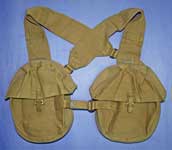
 This is the largest of the wartime ammunition Pouch designs. It is also unusual in that the Gun, Vickers, .303-IN., G.O. was primarily, but not exclusively, an R.A.F. aircraft weapon (known as a “K” Gun), but the Pouches are Army coded in Section A5/AE Assault and Commando Equipment. No introductory L. of C. has been noted, which would have been into V.A.O.S. Section A1/AA, in the 5000 series. James Ladd’s Commandos and Rangers confirms use of the G.O. Gun by Commandos “…to supplement LC (Landing Craft) fire before landing with Heavy Weapons Troop…”. As an expedient they were evidently also intended for use inland, hence thePouches.
This is the largest of the wartime ammunition Pouch designs. It is also unusual in that the Gun, Vickers, .303-IN., G.O. was primarily, but not exclusively, an R.A.F. aircraft weapon (known as a “K” Gun), but the Pouches are Army coded in Section A5/AE Assault and Commando Equipment. No introductory L. of C. has been noted, which would have been into V.A.O.S. Section A1/AA, in the 5000 series. James Ladd’s Commandos and Rangers confirms use of the G.O. Gun by Commandos “…to supplement LC (Landing Craft) fire before landing with Heavy Weapons Troop…”. As an expedient they were evidently also intended for use inland, hence thePouches.
In essence the envelope is a duplicate of the Lewis pouch, though far more oval in the vertical axis and with very different “extras”. The first difference is the presence of double hooks for direct attachment to a Waist belt - unlike the Lewis pouches. At the rear bottom edge was a large pad to prevent undue pressure on the upper thigh. At the top a 3 1/4-inch wide shoulder strap, with the ends tapered by folding to sandwich a short length of doubled 1-inch webbing. A pair of oval loops (same type as those used in Patt. '37 Cartridge carrier brace attachments) were retained by this doubled strap, forming a double-loop buckle. A 4-bar buckle (same as that on the Basic pouch) was positioned between the shoulder strap and the back of the Pouch. The whole is arranged so that a Pn. ’37 Brace can be buckled on, passing down behind the Pouch. There were two brace retaining loops to the front and rear of the shoulder strap.
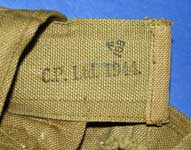
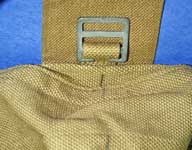 The left Pouch carries a 1-inch 3-bar buckle and chape on the front face, which buckles to a length of strap similarly mounted on the front of the right hand Pouch. This served to steady the unwieldy load on the chest. Viewed from the rear, the left Pouch has a loop and chape stitched at a 45 degree angle towards the left edge. This carries a length of 1-inch strap - a “diagonal strap”. The right hand had a mirrored arrangement. To assemble the set, the left shoulder strap was passed over the left shoulder and down towards the right hip. The diagonal strap on the right Pouch was brought up to meet it, being passed up through both dees and turned down through one of them. The shoulder straps therefore crossed on the back in the manner of a shoulder holster rig.
The left Pouch carries a 1-inch 3-bar buckle and chape on the front face, which buckles to a length of strap similarly mounted on the front of the right hand Pouch. This served to steady the unwieldy load on the chest. Viewed from the rear, the left Pouch has a loop and chape stitched at a 45 degree angle towards the left edge. This carries a length of 1-inch strap - a “diagonal strap”. The right hand had a mirrored arrangement. To assemble the set, the left shoulder strap was passed over the left shoulder and down towards the right hip. The diagonal strap on the right Pouch was brought up to meet it, being passed up through both dees and turned down through one of them. The shoulder straps therefore crossed on the back in the manner of a shoulder holster rig.
A pair of Pn. ’37 Braces could be worn, threaded through the loops on the shoulder straps and attached to the 1-inch 4-bar buckle. The chape assembly left a fairway for the Brace to pass down behind the Pouch. The Braces attached to the rear belt buckles as normal. The Pack could be hooked onto the 4-bar buckles in front, with Haversack and Water bottle carrier attached to the brace ends in the normal manner. Though it supplanted the Basic pouches, it did not have a “Patt. ‘37” nomenclature. Each Pouch was closed by a hinged lid, secured by a Q.R. fastener and each could contain a pair of drums The Pouch sets were made obsolete by L. of C. §C3375, approved 23rd March 1948. This set marked C.P. Ltd 1944, for Caoutchouc Products Ltd uses both Sheradised steel and brass fittings. From the collection of Ed Storey. Photographs © Ed Storey 2009.
The inclusion of a Belt, waist, small and Braces, long, raises some questions, since these items were already A1/AA coded under Patt. ’37 W.E.. The “figure of-eight” arrangement provided its own support, so perhaps the Belt was Patt. ’37 style, but without back buckles? Limitation, to a small size of waist belt, also seems odd. However, without Braces, no brace ends were available for the attachment of a Haversack or Water bottle carrier. Varying the Braces, sufficiently to warrant a new code, is also puzzling, as it’s hard to speculate how a Brace could be made to be “different” to the standard Patt. ’37 W.E. item.
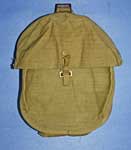
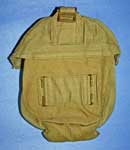
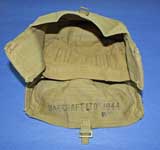 The entry A5/AE 0224 “…pouches, alternative…” was initially not fully understood. However, KWRT member Ed Storey has come up trumps! The Pouch illustrated has to have the strongest claim to being the “…alternative…” type. It would require support from Braces, but it is not “handed” – what the Army today call “Universal”. The 4-bar buckle is now mounted to the usual form of web chape-cum-fairlead, as on a Basic pouch. Marked Bagcraft, it is unfortunately dated 1944, a year too early for a stores code to be marked-on. From the collection of Ed Storey. Photographs © Ed Storey 2009.
The entry A5/AE 0224 “…pouches, alternative…” was initially not fully understood. However, KWRT member Ed Storey has come up trumps! The Pouch illustrated has to have the strongest claim to being the “…alternative…” type. It would require support from Braces, but it is not “handed” – what the Army today call “Universal”. The 4-bar buckle is now mounted to the usual form of web chape-cum-fairlead, as on a Basic pouch. Marked Bagcraft, it is unfortunately dated 1944, a year too early for a stores code to be marked-on. From the collection of Ed Storey. Photographs © Ed Storey 2009.
It has yet to be established if these were effectively a development progression. This could have been either way – additional support being added to the original design, or manufacture being simplified to the “alternative” form. It may be that the different pouch types relate to the Gun Numbers – No. 1 being equipped slightly differently to No. 2. Has anyone got a War Office S.A.T., or other handbook, with the answers?
Stores Ref. A1/AA 1819 Tabs, securing Bayonet, No. 4, Mk.I
Stores Ref. B2/AA 1819 Tabs, securing Bayonet, No. 4, Mk.I
Stores Ref. B1/AA 1819 Tabs, securing, Bayonet, No. 4, Mk.I
Stores Ref. B1/1005-99-961-9514 Tabs, securing, Bayonet, No. 4, Mk.I
 The narrow, tubular scabbard of the No. 4 Bayonet was an insecure fit in the existing bayonet frogs. L. of C. §B3806 therefore introduced the Tab, for use with the frogs of both Patt. ’08 W.E (A1/AA 0995) and Patt. ’37 W.E. (A1/AA 0996). It consisted of a leather tab, eyeleted at one end and with a brass keyhole fitting stitched to the other end. The chrome side of the leather faced the scabbard, as the tab was attached to the scabbard stud. The scabbard was then inserted into the Frog, with the leather tab folded over the top Frog loop, where the brass keyhole fastened over the scabbard stud. A.C.I. 36/1944, issued 8 January, 1944, transferred the Tabs from V.A.O.S. Section A1 to Section B2. The Frog modifications authorised in A.C.I. 375/1944, meant that all Tabs were to be returned to Royal Army Ordnance Corps stores, in effect now obsolete. Curiously, L. of C. §C416, approved 10 June, 1942, transferred the Tab from Section A1 to B1 “…in accordance with A.C.I. 36/1944…”. So, was it B1 Small Arms and their components, or B2 Small Arms Accessories, Tools and Packages?! B2 would seem to make more sense. However the answer seems to have been B1 – unless it moved again..?
The narrow, tubular scabbard of the No. 4 Bayonet was an insecure fit in the existing bayonet frogs. L. of C. §B3806 therefore introduced the Tab, for use with the frogs of both Patt. ’08 W.E (A1/AA 0995) and Patt. ’37 W.E. (A1/AA 0996). It consisted of a leather tab, eyeleted at one end and with a brass keyhole fitting stitched to the other end. The chrome side of the leather faced the scabbard, as the tab was attached to the scabbard stud. The scabbard was then inserted into the Frog, with the leather tab folded over the top Frog loop, where the brass keyhole fastened over the scabbard stud. A.C.I. 36/1944, issued 8 January, 1944, transferred the Tabs from V.A.O.S. Section A1 to Section B2. The Frog modifications authorised in A.C.I. 375/1944, meant that all Tabs were to be returned to Royal Army Ordnance Corps stores, in effect now obsolete. Curiously, L. of C. §C416, approved 10 June, 1942, transferred the Tab from Section A1 to B1 “…in accordance with A.C.I. 36/1944…”. So, was it B1 Small Arms and their components, or B2 Small Arms Accessories, Tools and Packages?! B2 would seem to make more sense. However the answer seems to have been B1 – unless it moved again..?
No L. of C. had been noted which made the Tab obsolete, so on the off-chance, the late Anthony Carter’s Bayonet Belt Frogs was consulted. In the addenda that forms an element of Part III were some astounding facts.. Thirty years after the R.A.F. made it obsolete, the Army’s V.A.O.S. Section B1 still had it listed – in 1974. It was qualified in the Detail column as being “…For use with Frogs, bayonet, No. 4, CN/AA 0996", which has to have been the 1st Issue. This means the 3rd Issue did not entirely supplant the 1st Issue, so its service life extends from 1940 to possibly even beyond 1974. Astounding! That’s without trying to understand why the No. 4, Mk. I, the original cruciform bladed form, was still extant. From the Graham Priest Collection, photographs © 2009 by Graham Priest.
Stores Ref. A1/AA 5XXX Carrier, grenade, special
Stores Ref. A5/AE 0060 Carrier, grenade, special
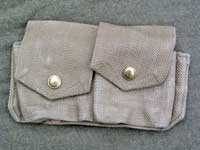
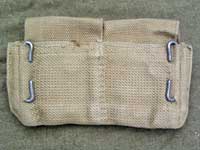 Although examples exist, little is known of its origins, or designated purpose, other than for carrying grenades. Readers have sent two forms of this Carrier, one of which was coded, which has at least allowed a positive identification. No L. of C., or A.C.I. has yet been noted.
Although examples exist, little is known of its origins, or designated purpose, other than for carrying grenades. Readers have sent two forms of this Carrier, one of which was coded, which has at least allowed a positive identification. No L. of C., or A.C.I. has yet been noted.
The standard form, that made by M.E.Co., is integrally woven, with a bellows base, as in the original standards of Patt. ’37 W.E. Compass pocket and Pistol ammunition pouch. The Carrier is made like the Patt. ’37 W.E. Cartridge carrier, but with parallel-sided pockets, not tapered. The reverse has two belt hooks, fitted directly through the backing fabric, as with Cartridge carriers, but with no point of attachment for the Braces, as this Carrier would have been worn disposed towards the left or right hip of the wearer. The example at left is courtesy of WD Militaria.

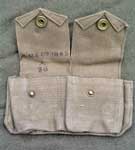
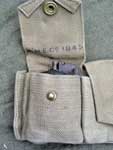 Each Carrier accommodated a pair of No. 36 Grenades, the later iteration of the Great War Mills Bomb. However, it is not clear if “special” refers to the grenade, or the Carrier! If the former, one suggestion has been that it might be for the No. 69 Bakelite Grenade, which had a “plastic” case and was designed for use at close quarters, as it had a lesser lethal radius than the No. 36. It might have been necessary to isolate these from being damaged in a mixed pouch load with magazines. This is plausible, since the V.A.O.S. Section is A5, Commando and Assault Equipment. Commandos often carried Bergen rucksacks, rather than complete Patt. ’37 W.E. sets, the belt of which would interfere with the lumbar support strap of the Bergen. The No. 69 grenade shown right is taken from the very informative The Mills Grenade Collectors Site. Photo © David Sampson 2008. Karkee Web contributor Paul Laidlaw has now confirmed that the No. 69 Grenade is too tall and won't fit in this Carrier.
Each Carrier accommodated a pair of No. 36 Grenades, the later iteration of the Great War Mills Bomb. However, it is not clear if “special” refers to the grenade, or the Carrier! If the former, one suggestion has been that it might be for the No. 69 Bakelite Grenade, which had a “plastic” case and was designed for use at close quarters, as it had a lesser lethal radius than the No. 36. It might have been necessary to isolate these from being damaged in a mixed pouch load with magazines. This is plausible, since the V.A.O.S. Section is A5, Commando and Assault Equipment. Commandos often carried Bergen rucksacks, rather than complete Patt. ’37 W.E. sets, the belt of which would interfere with the lumbar support strap of the Bergen. The No. 69 grenade shown right is taken from the very informative The Mills Grenade Collectors Site. Photo © David Sampson 2008. Karkee Web contributor Paul Laidlaw has now confirmed that the No. 69 Grenade is too tall and won't fit in this Carrier.
The Bergen’s shoulder straps were fitted with short tab straps, 1.5-inches wide. These might be “grab tabs”, to temporarily relieve the shoulders. However, it seems more than coincidental that Utility pouches can therefore be attached and are seen in photographs. These were functioning as Basic pouches and their larger size would mean mixed contents being less readily accessible. If it was grenades, of the two types, you would not want to scrabble around blind, to reach the right grenade. Alternatively, Commandos made heavier use of Thompson and Sten Machine Carbines. Carrying more magazines than an infantryman, it may have meant the grenades had to be displaced to a “Special” Carrier.
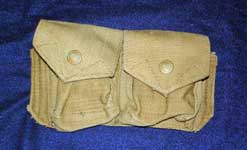
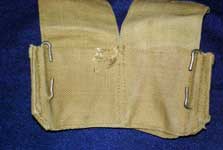
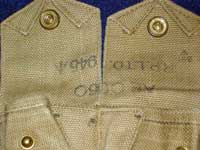
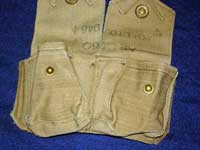 The second form illustrated is of “folded-and-stitched” construction. Marked R.P. Ltd for R. Parkyn, this is of 1945 manufacture, so is coded, as should the M.E.Co. example be from the same year. Parkyn were just one of the many manufacturers drawn into the production of web equipment, but who could not integrally weave products. This example is from the Tony Cone Collection. Photo © Tony Cone 2009.
The second form illustrated is of “folded-and-stitched” construction. Marked R.P. Ltd for R. Parkyn, this is of 1945 manufacture, so is coded, as should the M.E.Co. example be from the same year. Parkyn were just one of the many manufacturers drawn into the production of web equipment, but who could not integrally weave products. This example is from the Tony Cone Collection. Photo © Tony Cone 2009.
Despite the lack of L. of C.s, the 1948 V.A.O.S. listing for A5 still lists this item, but no date is known for it becoming obsolete.
KW will be delighted to hear from any reader, who can shed more light and provide a contemporary photo of Commandos wearing the Carrier. Equally, if anyone has a Sealed Pattern, the label may show the original A1/AA code in the 5000 sequence.